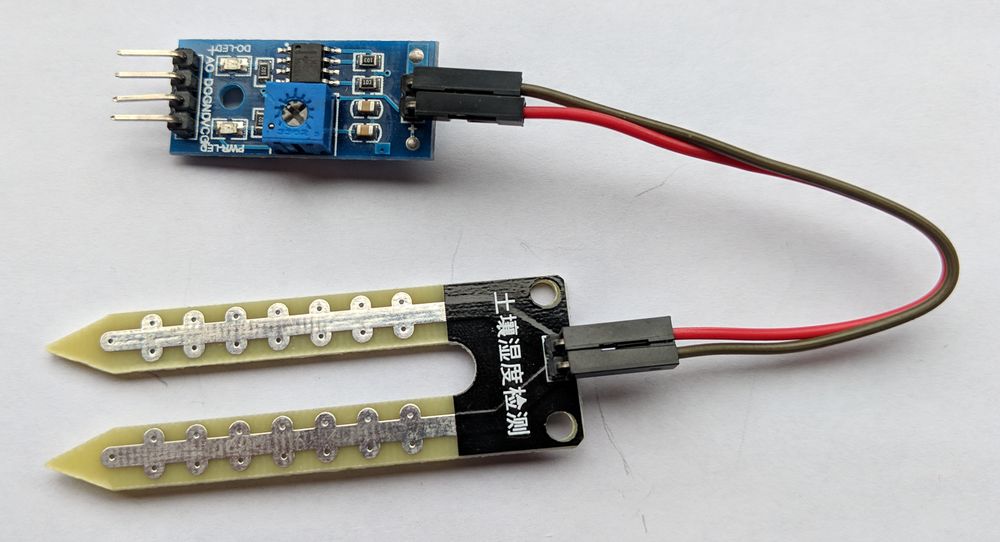Meadow.Foundation.Sensors.Moisture.Fc28
| Fc28 | |
|---|---|
| Status |  |
| Source code | GitHub |
| Datasheet(s) | GitHub |
| NuGet package |  |
FC-28 Soil Moisture Sensor is a simple breakout for measuring the moisture in soil and similar materials. The sensor has two probes and measures the resistance between them, which means this sensor is of type Resistive. Since water is conductive, as moisture in the soil increases, the resistance decreases allowing the sensor to determine soil humidity.

The biggest issue of this sensor is the corrosion of the probes, not just because it is in contact with the soil but also because there is a DC current flowing which causes electrolysis of the sensors. A work-around to prolong the life of the probes is to not constantly have the sensor powered on, but activate it every time the sensor will perform a read using a digital output port connected to the VCC pin. The code and circuit example shows you how to use it.
The following example shows how read the soil moisture every second:
public class MeadowApp : App<F7Micro, MeadowApp>
{
Fc28 fc28;
public MeadowApp()
{
Console.WriteLine("Initializing...");
fc28 = new Fc28(
Device.CreateAnalogInputPort(Device.Pins.A01),
Device.CreateDigitalOutputPort(Device.Pins.D15),
minimumVoltageCalibration: 3.24f,
maximumVoltageCalibration: 2.25f
);
TestFC28Updating();
}
void TestFC28Updating()
{
Console.WriteLine("TestFC28Updating...");
fc28.Subscribe(new FilterableObserver<FloatChangeResult, float>(
h => { Console.WriteLine($"Moisture values: {Math.Truncate(h.New)}, old: {Math.Truncate(h.Old)}, delta: {h.DeltaPercent}"); },
e => { return true; }
));
fc28.Updated += (object sender, FloatChangeResult e) =>
{
Console.WriteLine($"Moisture Updated: {e.New}");
};
fc28.StartUpdating();
}
}
Sample projects available on GitHub
Code Example
Fc28 fc28;
public override Task Initialize()
{
Resolver.Log.Info("Initialize...");
fc28 = new Fc28(
Device.CreateAnalogInputPort(Device.Pins.A01, 5, TimeSpan.FromMilliseconds(40), new Voltage(3.3, Voltage.UnitType.Volts)),
Device.CreateDigitalOutputPort(Device.Pins.D15),
minimumVoltageCalibration: new Voltage(3.24f, VU.Volts),
maximumVoltageCalibration: new Voltage(2.25f, VU.Volts)
);
var consumer = Fc28.CreateObserver(
handler: result =>
{
// the first time through, old will be null.
string oldValue = (result.Old is { } old) ? $"{old:n2}" : "n/a";
Resolver.Log.Info($"Subscribed - " +
$"new: {result.New}, " +
$"old: {oldValue}");
},
filter: null
);
fc28.Subscribe(consumer);
fc28.Updated += (object sender, IChangeResult<double> e) =>
{
Resolver.Log.Info($"Moisture Updated: {e.New}");
};
return Task.CompletedTask;
}
public async override Task Run()
{
var moisture = await fc28.Read();
Resolver.Log.Info($"Moisture Value {moisture}");
fc28.StartUpdating(TimeSpan.FromMilliseconds(5000));
}
Sample project(s) available on GitHub
Wiring Example
Class Fc28
FC-28-D Soil Hygrometer Detection Module + Soil Moisture Sensor
Assembly: Fc28.dll
View Source
public class Fc28 : PollingSensorBase<double>, IObservable<IChangeResult<double>>, IMoistureSensor, ISamplingSensor<double>, ISensor<double>, ISensor, ISamplingSensor, IDisposable
Inheritance: System.Object -> Meadow.Foundation.ObservableBase<UNIT>
Implements:
System.IObservable<Meadow.IChangeResult<System.Double>>, Meadow.Peripherals.Sensors.Moisture.IMoistureSensor, Meadow.Peripherals.Sensors.ISamplingSensor<System.Double>, Meadow.Peripherals.Sensors.ISensor<System.Double>, Meadow.Peripherals.Sensors.ISensor, Meadow.Peripherals.Sensors.ISamplingSensor, System.IDisposable
Properties
AnalogInputPort
Returns the analog input port
View Source
protected IAnalogInputPort AnalogInputPort { get; }
DigitalOutputPort
Returns the digital output port
View Source
protected IDigitalOutputPort DigitalOutputPort { get; }
Moisture
Last value read from the moisture sensor
View Source
public double? Moisture { get; protected set; }
MinimumVoltageCalibration
Voltage value of most dry soil - default is 0 volts
View Source
public Voltage MinimumVoltageCalibration { get; set; }
MaximumVoltageCalibration
Voltage value of most moist soil - default of 3.3V
View Source
public Voltage MaximumVoltageCalibration { get; set; }
IsDisposed
Is the object disposed
View Source
public bool IsDisposed { get; }
Methods
ReadSensor()
Reads data from the sensor
View Source
protected override Task<double> ReadSensor()
Returns
System.Threading.Tasks.Task<System.Double>: The latest sensor reading### VoltageToMoisture(Voltage)
Converts voltage to moisture value, ranging from 0 (most dry) to 1 (most wet)
View Source
protected double VoltageToMoisture(Voltage voltage)
Returns
System.Double
Parameters
| Type | Name |
|---|---|
Meadow.Units.Voltage | voltage |
Dispose()
Performs application-defined tasks associated with freeing, releasing, or resetting unmanaged resources.
View Source
public void Dispose()
Dispose(bool)
Dispose of the object
View Source
protected virtual void Dispose(bool disposing)
Parameters
| Type | Name | Description |
|---|---|---|
System.Boolean | disposing | Is disposing |
Implements
System.IObservable<Meadow.IChangeResult<System.Double>>Meadow.Peripherals.Sensors.Moisture.IMoistureSensorMeadow.Peripherals.Sensors.ISamplingSensor<System.Double>Meadow.Peripherals.Sensors.ISensor<System.Double>Meadow.Peripherals.Sensors.ISensorMeadow.Peripherals.Sensors.ISamplingSensorSystem.IDisposable